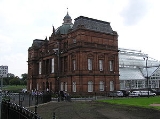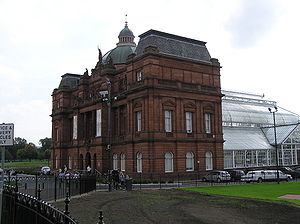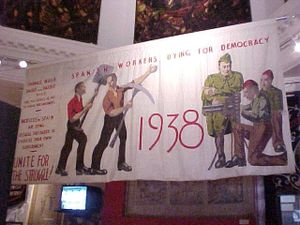
People's Palace
Encyclopedia




Glasgow
Glasgow is the largest city in Scotland and third most populous in the United Kingdom. The city is situated on the River Clyde in the country's west central lowlands...
, Scotland
Scotland
Scotland is a country that is part of the United Kingdom. Occupying the northern third of the island of Great Britain, it shares a border with England to the south and is bounded by the North Sea to the east, the Atlantic Ocean to the north and west, and the North Channel and Irish Sea to the...
is a museum
Museum
A museum is an institution that cares for a collection of artifacts and other objects of scientific, artistic, cultural, or historical importance and makes them available for public viewing through exhibits that may be permanent or temporary. Most large museums are located in major cities...
and glasshouse situated in Glasgow Green
Glasgow Green
Glasgow Green is a park situated in the east end of Glasgow on the north bank of the River Clyde. It is the oldest park in the city dating back to the 15th century.In 1450, King James II granted the land to Bishop William Turnbull and the people of Glasgow...
, and was opened on 22 January, 1898 by the Earl of Rosebery
Earl of Rosebery
Earl of Rosebery is a title in the Peerage of Scotland. It was created in 1703 for Archibald Primrose, 1st Viscount of Rosebery, with remainder to his issue male and female successively...
.
At the time, the East End of Glasgow was one of the most unhealthy and overcrowded parts of the city, and the People's Palace was intended to provide a cultural centre for the people. It was designed by the City Engineer, Alexander B. McDonald. At the opening ceremony Lord Rosebery stated: "A palace of pleasure and imagination around which the people may place their affections and which may give them a home on which their memory may rest". He declared the building "Open to the people for ever and ever".
Originally, the ground floor of the building provided reading and recreation rooms, with a museum on the first floor, and a picture gallery on the top floor. Since the 1940s, it has been the museum of social history
Social history
Social history, often called the new social history, is a branch of History that includes history of ordinary people and their strategies of coping with life. In its "golden age" it was a major growth field in the 1960s and 1970s among scholars, and still is well represented in history departments...
for the city of Glasgow, and tells the story of the people and the city from 1750 to the present day. The collections and displays reflect the changing face of the city and the different experiences of Glaswegians at home, work and leisure. Current displays (as of March 2009) include glimpses of typical Glasgow history such as life in a 'single end' (a one-room tenement home), going to 'The Steamie' (the communal laundry), nights out at 'The Dancing' in the famous Barrowland Ballroom
Barrowland Ballroom
The Barrowlands is a major dance hall and concert venue in Glasgow, Scotland.-History of Barrowland Ballroom:The original building opened in 1934 in a mercantile area east of Glasgow's city centre...
and trips 'Doon The Watter' (down the firth of Clyde
Firth of Clyde
The Firth of Clyde forms a large area of coastal water, sheltered from the Atlantic Ocean by the Kintyre peninsula which encloses the outer firth in Argyll and Ayrshire, Scotland. The Kilbrannan Sound is a large arm of the Firth of Clyde, separating the Kintyre Peninsula from the Isle of Arran.At...
) on steamer
Clyde steamer
The era of the Clyde steamer in Scotland began in August 1812 with the very first successful commercial steamboat service in Europe, when Henry Bell's began a passenger service on the River Clyde between Glasgow and Greenock...
s such as the Waverly
PS Waverley
PS Waverley is the last seagoing passenger carrying paddle steamer in the world. Built in 1946, she sailed from Craigendoran on the Firth of Clyde to Arrochar on Loch Long until 1973...
.
The building was closed for almost two years, to allow restoration work to be carried out, with the re-opening being timed to coincide with the 100-year anniversary of its first opening in 1898, and this is recorded on a plaque mounted just inside the main entrance. Renovations extended to include the Winter Gardens to the rear of the building, where the glasshouse was extensively restored and reglazed, and the gardens tidied.
As part of the restoration the artist Ken Currie
Ken Currie
Ken Currie is a Scottish painter, one of the most influential living artists in Scotland. His paintings are displayed in public and museum collections worldwide....
was commissioned to create a series of paintings for the ceiling dome of the museum. The eight panels mark the 200th anniversary of the Calton weavers
Calton weavers
The Calton weavers were a community of handweavers established in the community of Calton, then in Lanarkshire just outside Glasgow, Scotland in the 18th century. In 1787 the weavers went on strike...
Massacre of 1787 and depict the history of Glasgow's workers from that point to the present day.
In 2005 further work was carried out when the Doulton Fountain was extensively refurbished and relocated to its present position in front of the museum. At 46 feet high and 70 feet across at its base, it is the largest terracotta fountain in the world. It was originally gifted to the city in 1888 after the International Exhibition of Science, Art and Industry
International Exhibition of Science, Art and Industry
The International Exhibition of Science, Art and Industry was the first of 4 international exhibitions held in Glasgow, Scotland during the late 19th and early 20th centuries. It took place at Kelvingrove Park between May and November 1888...
by Sir Henry Doulton
Henry Doulton
Sir Henry Doulton was an English businessman, inventor and manufacturer of pottery, instrumental in developing the firm of Royal Doulton....
to commemorate Queen Victoria’s Golden Jubilee, and is decorated with a figure of the Queen and groups from Canada, Australia, India and South Africa representing Britain's Empire.
During the 1980s, one employee gained local fame when she became a member of the General, Municipal and Boilermakers Trade Union, after NALGO refused her admission as a blue collar worker. This was Smudge
Smudge (cat)
Smudge was a feline that became a minor celebrity in Glasgow.Employed by the People's Palace museum in Glasgow Green to deal with a rodent problem in 1979, Smudge became a fixture of the museum, which sold Smudge merchandise including ceramic replicas designed by noted potter Margery Clinton...
, the People's Palace cat, who ensured the building did not become home to small, unwelcome visitors. Glasgow's Lord Provost
Lord Provost
A Lord Provost is the figurative and ceremonial head of one of the principal cities of Scotland. Four cities, Aberdeen, Dundee, Edinburgh and Glasgow, have the right to appoint a Lord Provost instead of a provost...
made press appeals and police searches were carried out when she disappeared for 3 weeks in 1987, eventually re-appearing none the worse for wear less than half a mile away.

